About Stocks by Locations
Stocks by Locations is an Odoo module to provide essential inventory data for products at a glance, and to keep details by locations easy reachable and clear.
The app introduces the widget for product templates, variants, and sale orders to work with stocks in a comfortable manner. The internal locations are structured hierarchically, while you may expand or hide any of those. Locations without products on hand or without products planned are excluded to provide a clearer picture.
Get an instant overview of stock levels from product variant or template forms, and right from a sales line. You would have full information over all available internal locations for quantity on hand, free to use quantity, reserved quantity, forecast quantity, incoming and outgoing quants.
At a glance at products, users observe the inventories which are essential for them. So, Odoo stock levels are calculated for the default warehouse, but total inventories are still available.
Export stock levels in a single button click right from a product form.
Expandable locations' hierarchy
Inventory for products and sale lines
User warehouse inventory levels
Excel table inventories by locations
Odoo Product Inventory Interfaces
The aim of the module is to show inventory levels per each internal location for backend comfortable use. For that, the module introduces the widget. The widget shows a table, which gives an instant overview of stock levels from product variant or template forms, and right from a sales line. You would have full information over all available internal locations for quantity on hand, free to use quantity, reserved quantity, forecast quantity, incoming and outgoing quants.
The internal locations are structured hierarchically, while you may expand or hide any of those.
To expand the hidden warehouses, click on the 'Down Arrow' icon by the warehouse or location.
To hide the open warehouses, click on the 'Up Arrow' icon by the warehouse or location.
You can also expand all warehouses in one click. For that, find the 'Double Arrows' on the left side of the title 'Location'.
The 'Side Arrow' stands by the last location, which can no longer be expanded.
Locations without products on hand or without products planned are excluded to provide a clearer picture.
Below the table, you can find the button 'Export to XLSX' click on it to export the stock balance table (see Stock Levels Export).
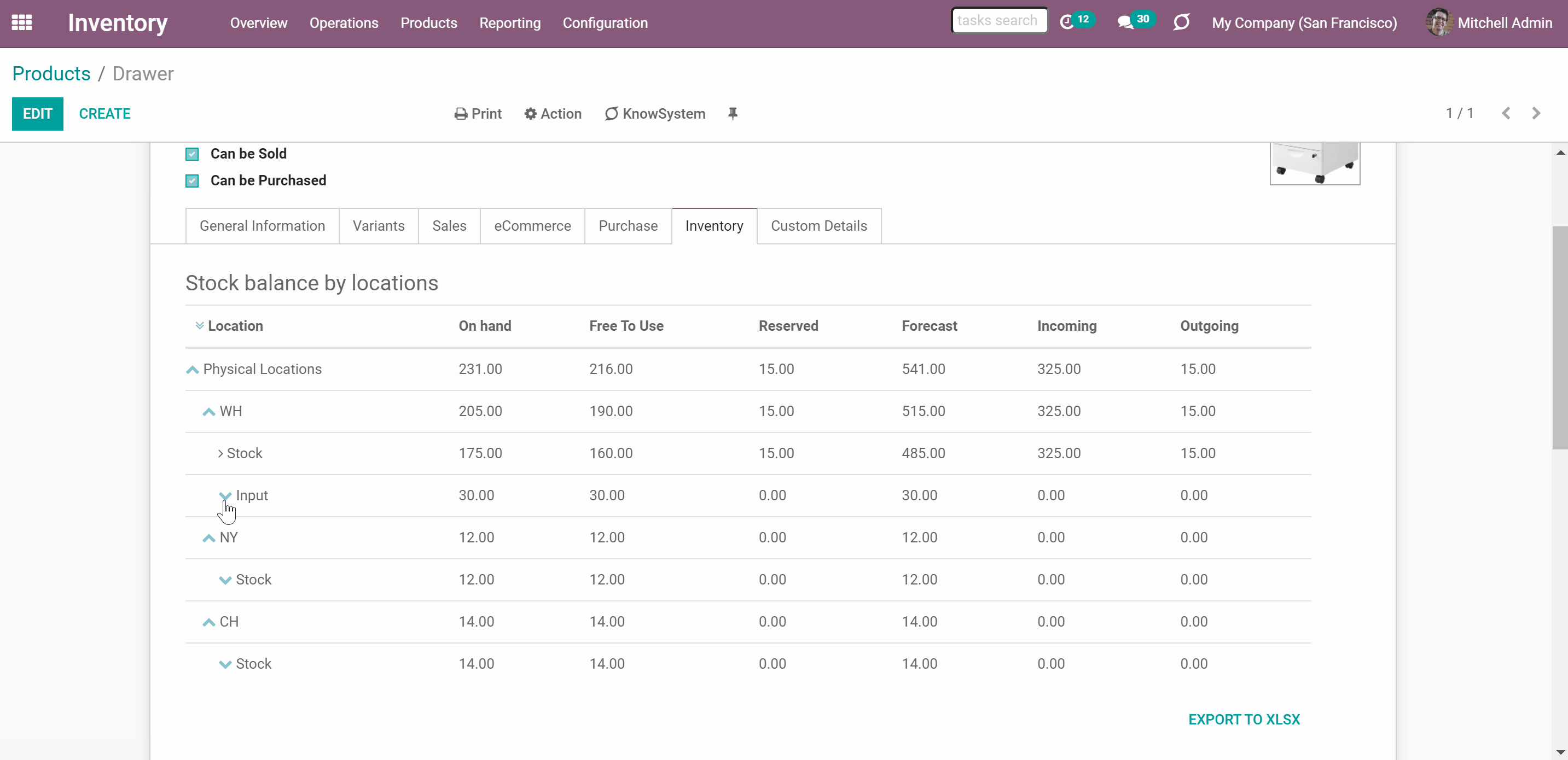
The module updates the stock balance in real-time. But, there might be some delays, when there are a lot of products and warehouses. To avoid high system resource consumption, it is also possible to hide the table and show the button instead (see Stocks by Locations Configuration).
The module doesn't influence user's access rights. The access rights are regulated by Odoo or might be regulated by other third-party apps. If there are some limitations to the warehouses or locations, then users will not see them. So, it is possible, that the table will look differently for various users.
The widget appears on:
1. Product template
2. Product variants' forms
3. Sale Order's form
Product Template
The 'Stocks by locations' widget is added to each storable and consumable product template. To see the availability of a particular product, just open the product's card, go to the tab Inventory and find the section Stock Balance by Locations. There you will find a table, which shows the number of this product in each warehouse.
As a product is a group of variants (items) of one model, the quantity is shown for all its variants.
Click on the button 'Export to XLSX' to export the stock balance table (see Stock Levels Export).
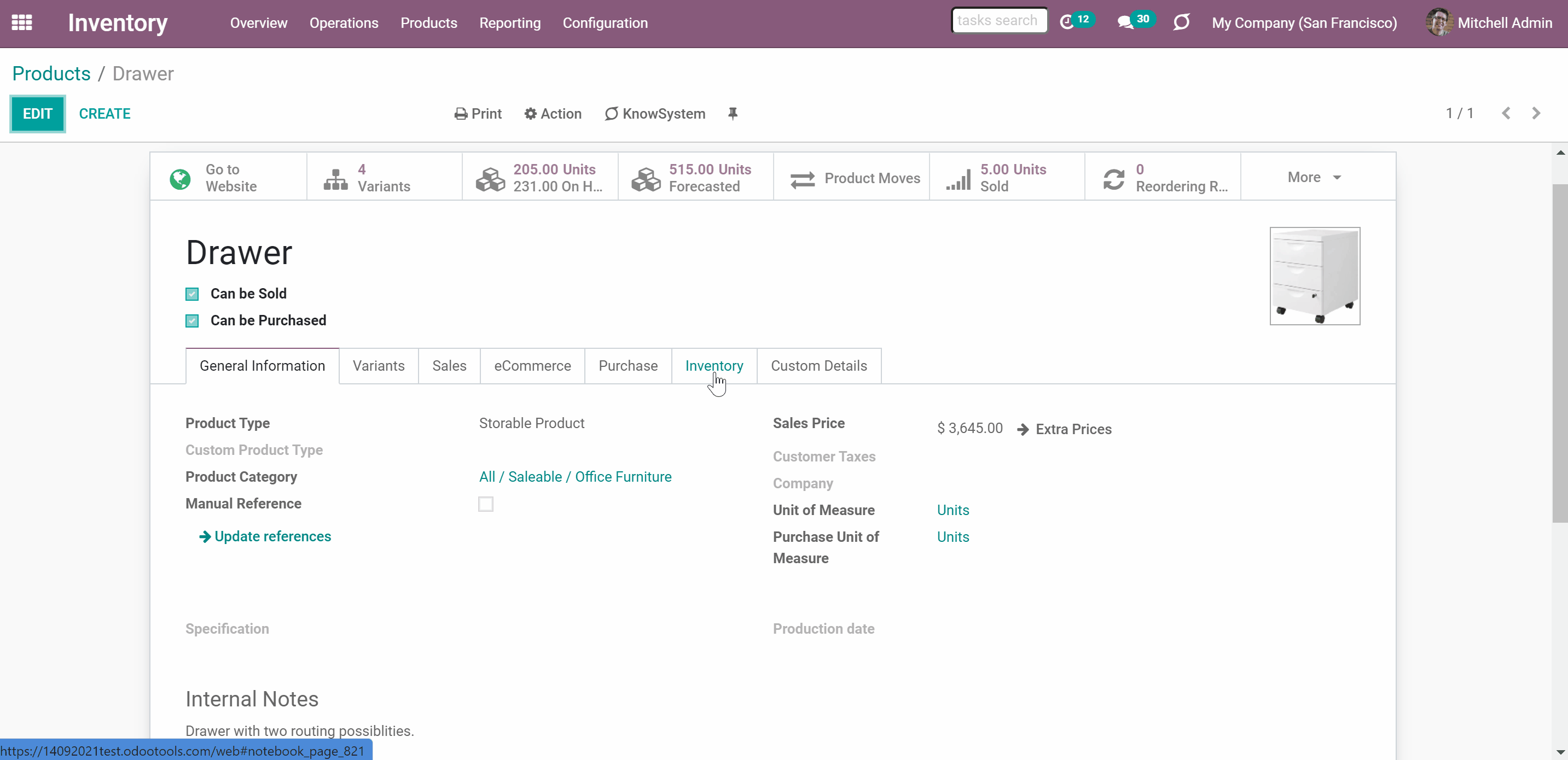
The module also changes the button on the product's form. Now the available quantity of the product is shown not in all warehouses, but only in the default one. The available quants for all product variants are shown. Thus, users observe the inventories which are essential for them. However, a user still can check other warehouses using the widget ‘Stocks by locations’ if necessary.
The default warehouse can be configured on the user form right under the Signature.
Here, in the picture, the user's default warehouse is 'WH'. So, the number in the button, which is higher shows the stocks of the 'WH' warehouse, that is 428.00 Units. And the number below, 454.00, shows total stocks by all locations.
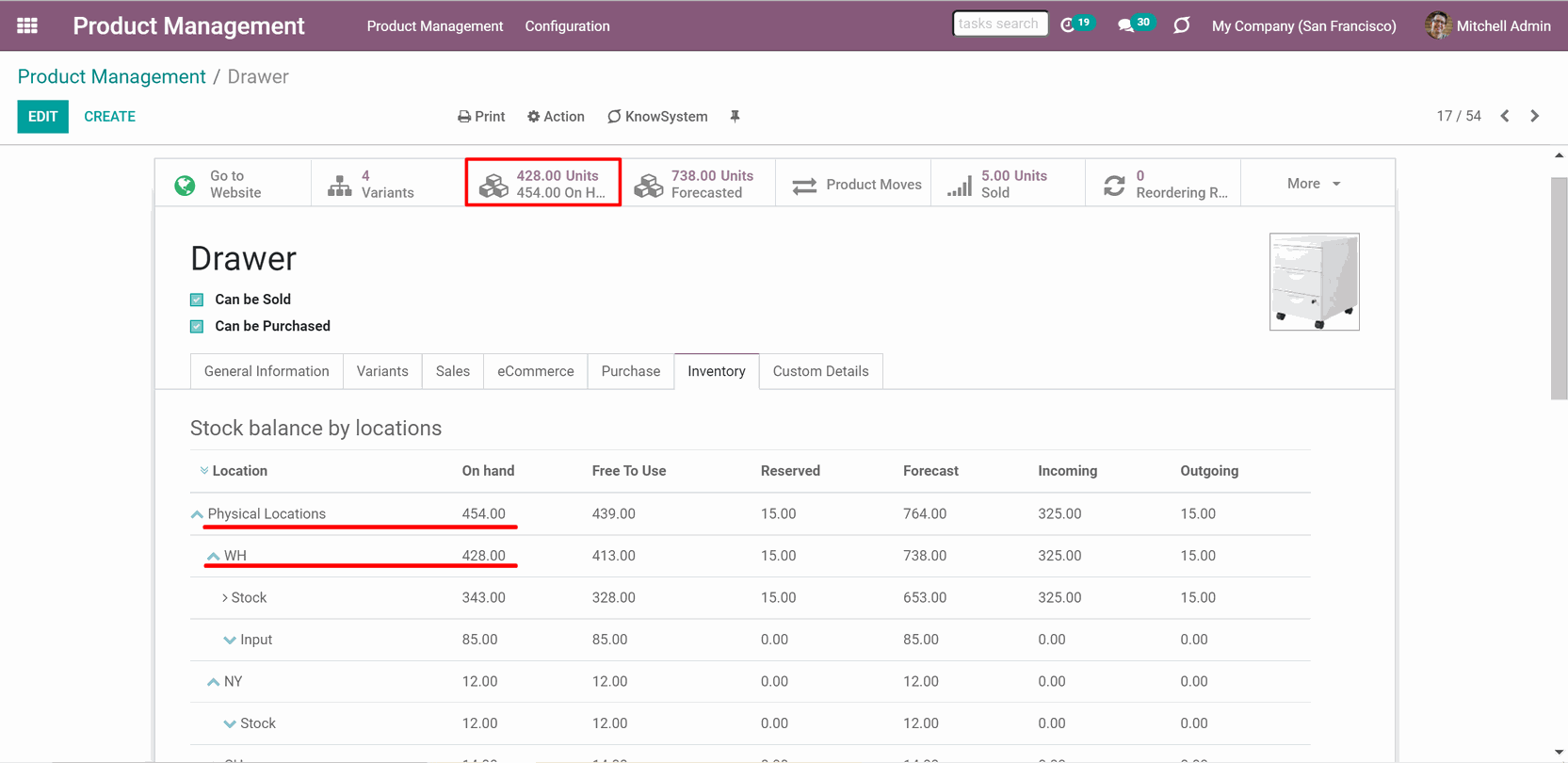
The information about the quantity of the product in the default warehouse can be also seen from both the kanban and list view of the product. The second number shows the quantity of the product in all locations.
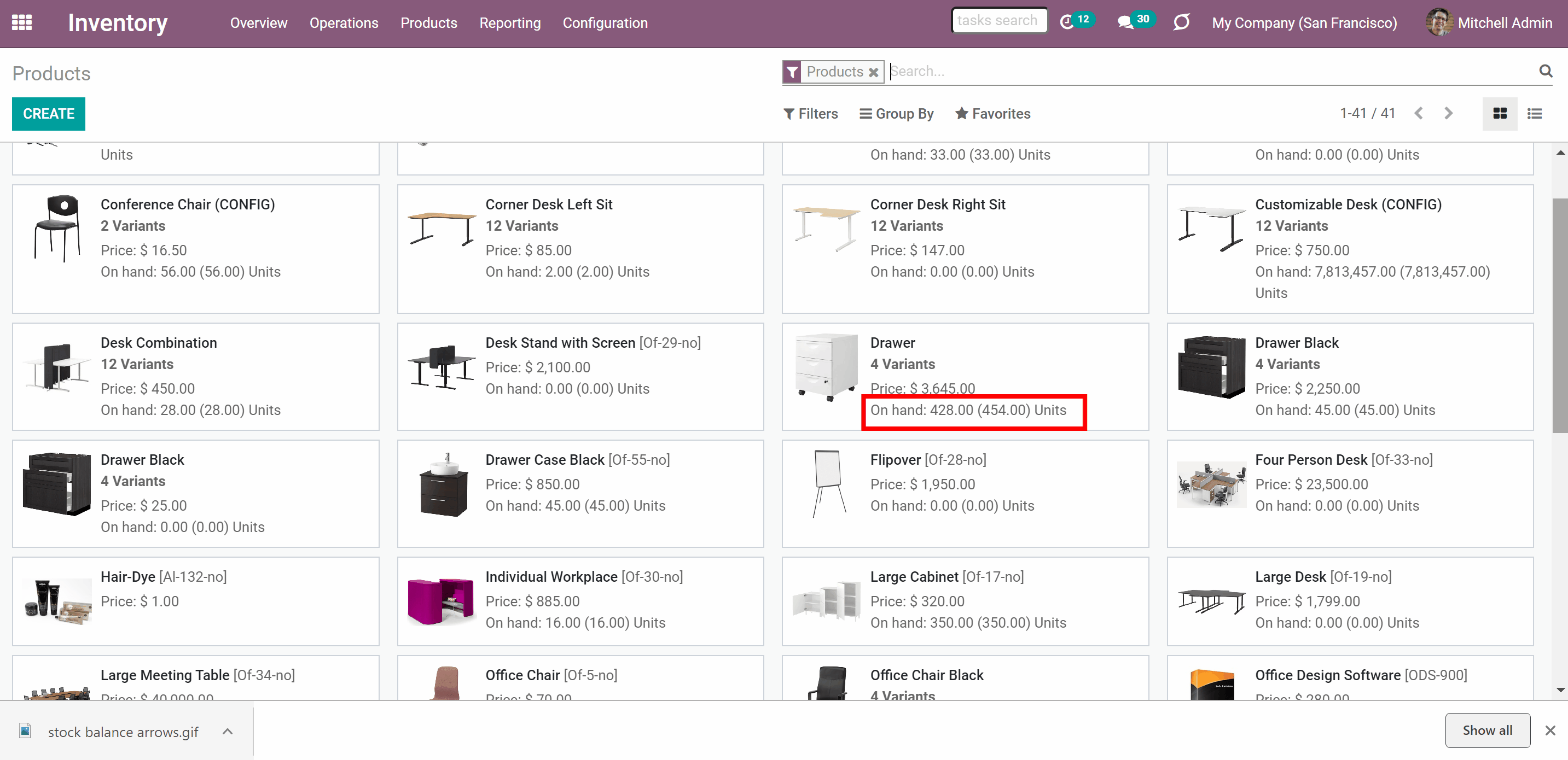
Product Variant's Form
The 'Stocks by locations' widget is added not only to the storable and consumable product's template but also to the storable and consumable product's variants' forms. A product variant is a specific version of a particular product. So, it is also possible to see the quants of a particular product variant in various locations.
To see stocks of a product variant:
1. Open the product's template and click on the button 'Variants'
2. Choose a variant and open its form
3. Find the section 'Stocks by location'
Click on the button 'Export to XLSX' to export the stock balance table (see Stock Levels Export).

You can also open the product variant from the product variant's menu by going to Inventory > Products > Product Variants. There as in the product's template you will see the button, which shows the available quantity of the product variant in the default warehouse. Thus, users observe the inventories which are essential for them. However, a user still can check other warehouses using the widget ‘Stocks by locations’ if necessary.
Here, in the picture, the user's default warehouse is 'WH'. So, the number in the button, which is higher shows the stocks of the 'WH' warehouse, that is 100.00 Units. And the number below, 155.00, shows the total stocks of the product variant by all locations.
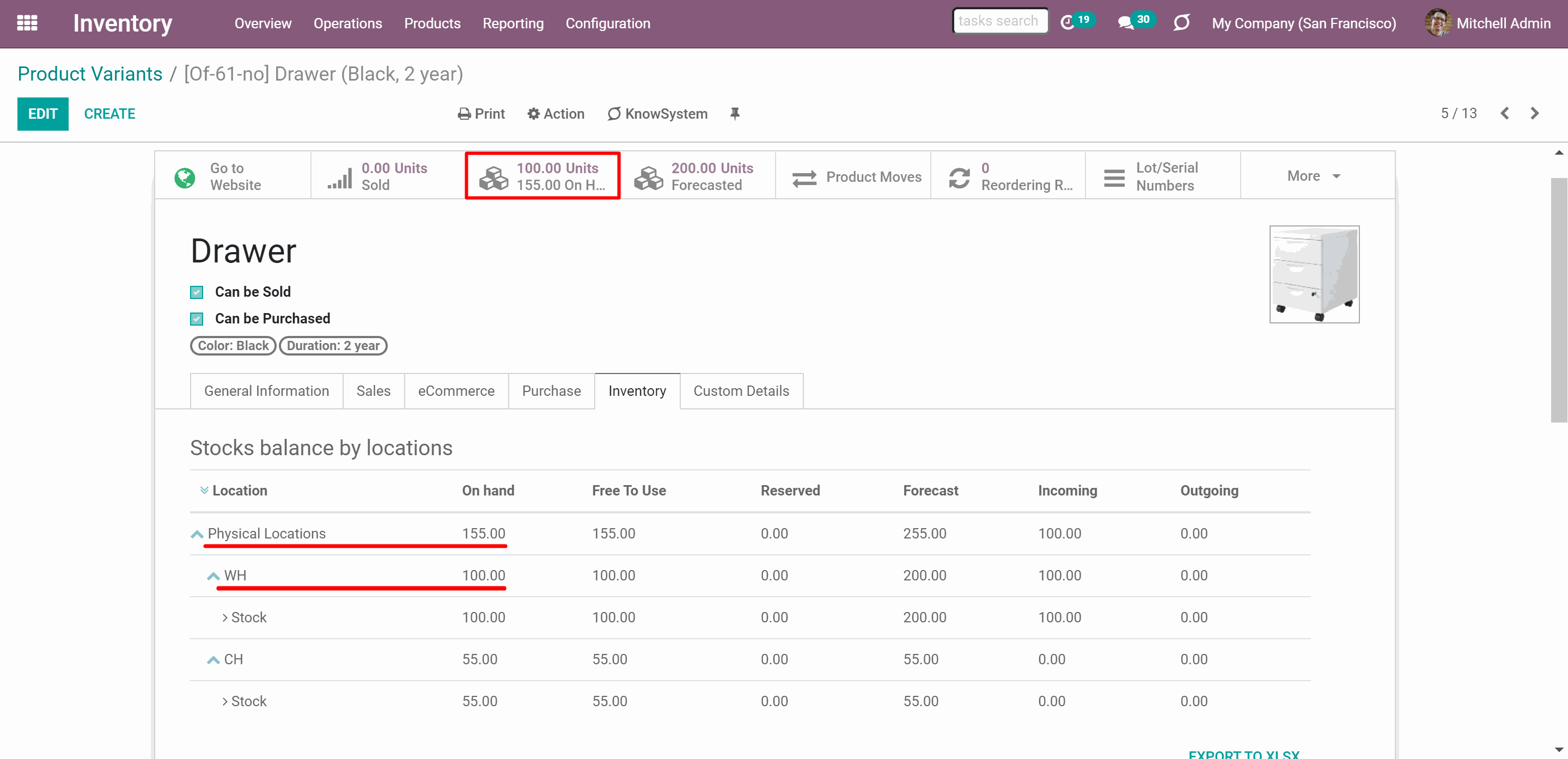
The information about the quantity of the product variant in the default warehouse can be also seen from the list view in the product variant's menu. The second number shows the quantity of the product in all locations.
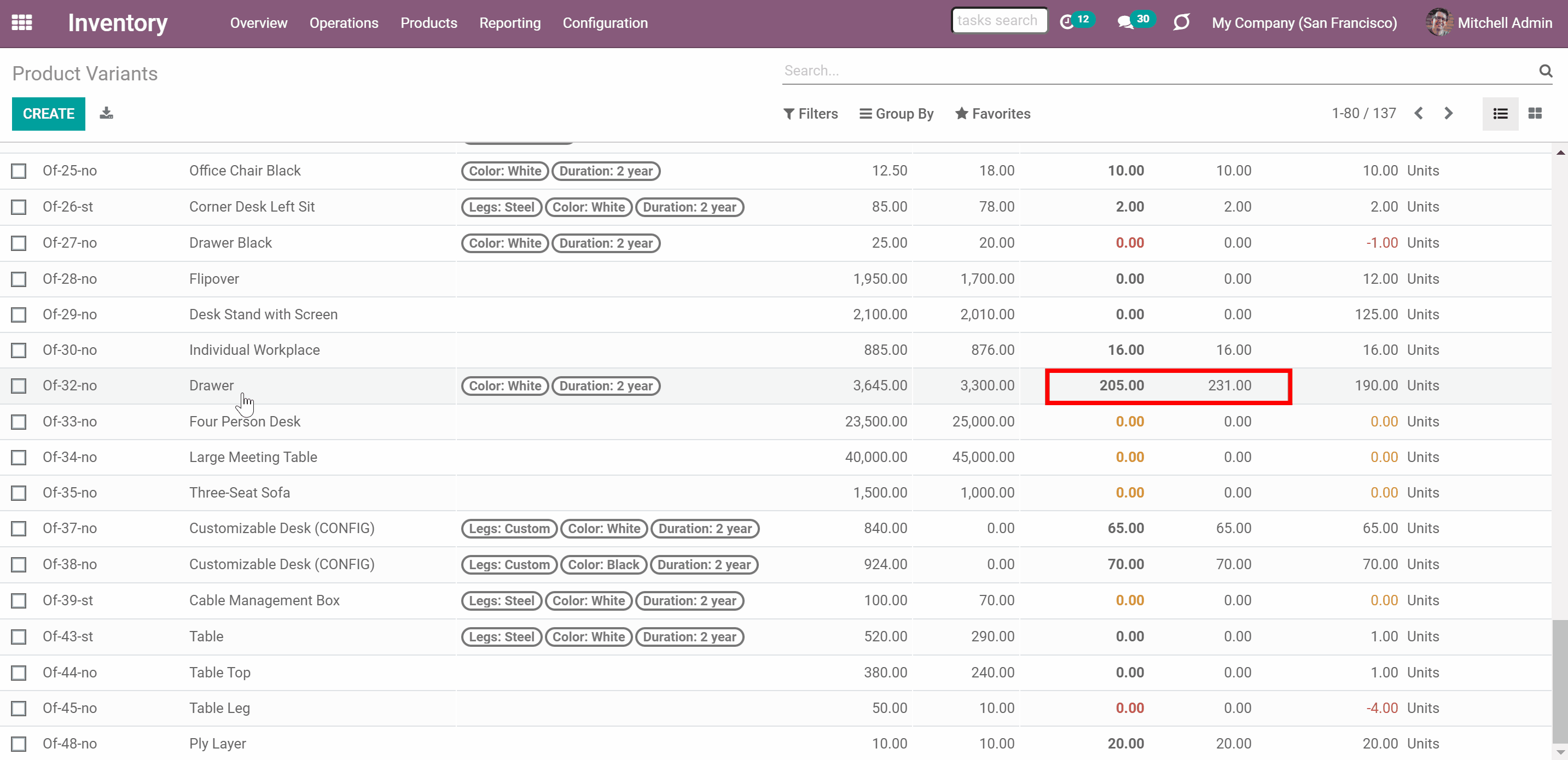
Sale Order's Form
The module introduces the tool for Odoo salespersons to control inventory levels when working with quotations. With the 'Stock by locations' widget, you can get an instant overview of stock levels right from a sales line.
To see the stocks of a product from a sale order, just click on the 'List' icon by the product, on the right side, after the 'Subtotal' column.
The table contains full information over all available internal locations for quantity on hand, free-to-use quantity, reserved quantity, forecast quantity, incoming and outgoing quants.
The module helps to check the availability of a product in all locations if there isn't enough product in stock in the default one.
For example, a sale order for 10 drawers was created. However, in the default warehouse, there were only 8 drawers. So, the salesperson checks the availability of the drawers in other places and suggests the buyer waiting in case the delivery will take longer.
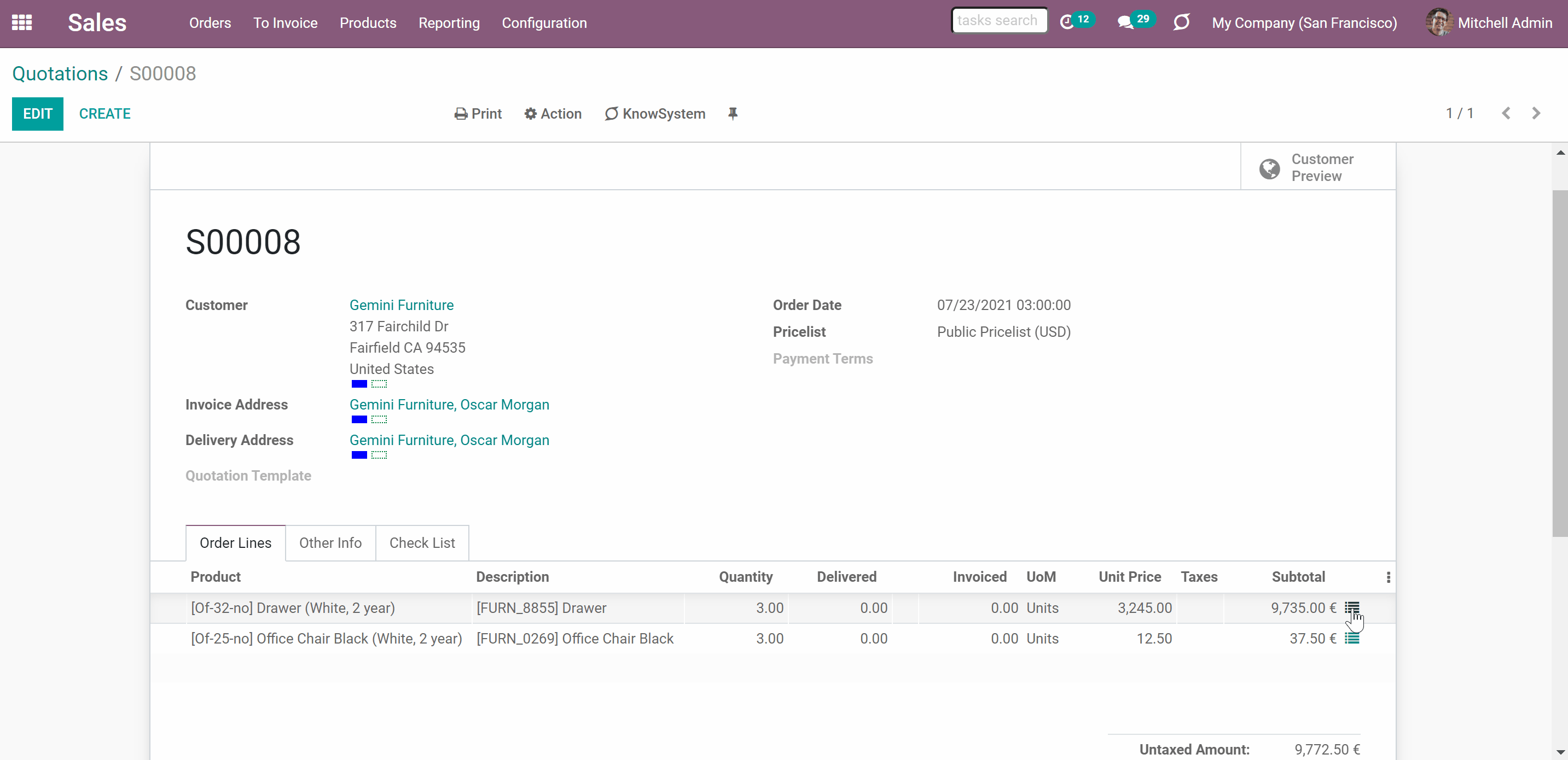
Stock Levels Export
It is possible to export the product's stock levels. For that,
1. Open a product template or a product's variant form
2. Go to the tab 'Inventory'
3. Find the tab 'Stock balance by locations'
4. On the right side below the table click the button 'Export to XLSX' and the downloading will start automatically.
The exported document preserves the table 'Stock by Locations' structure. The hierarchy levels are presented. You see full information over all available internal locations for quantity on hand, free-to-use quantity, reserved quantity, forecast quantity, incoming and outgoing quants.
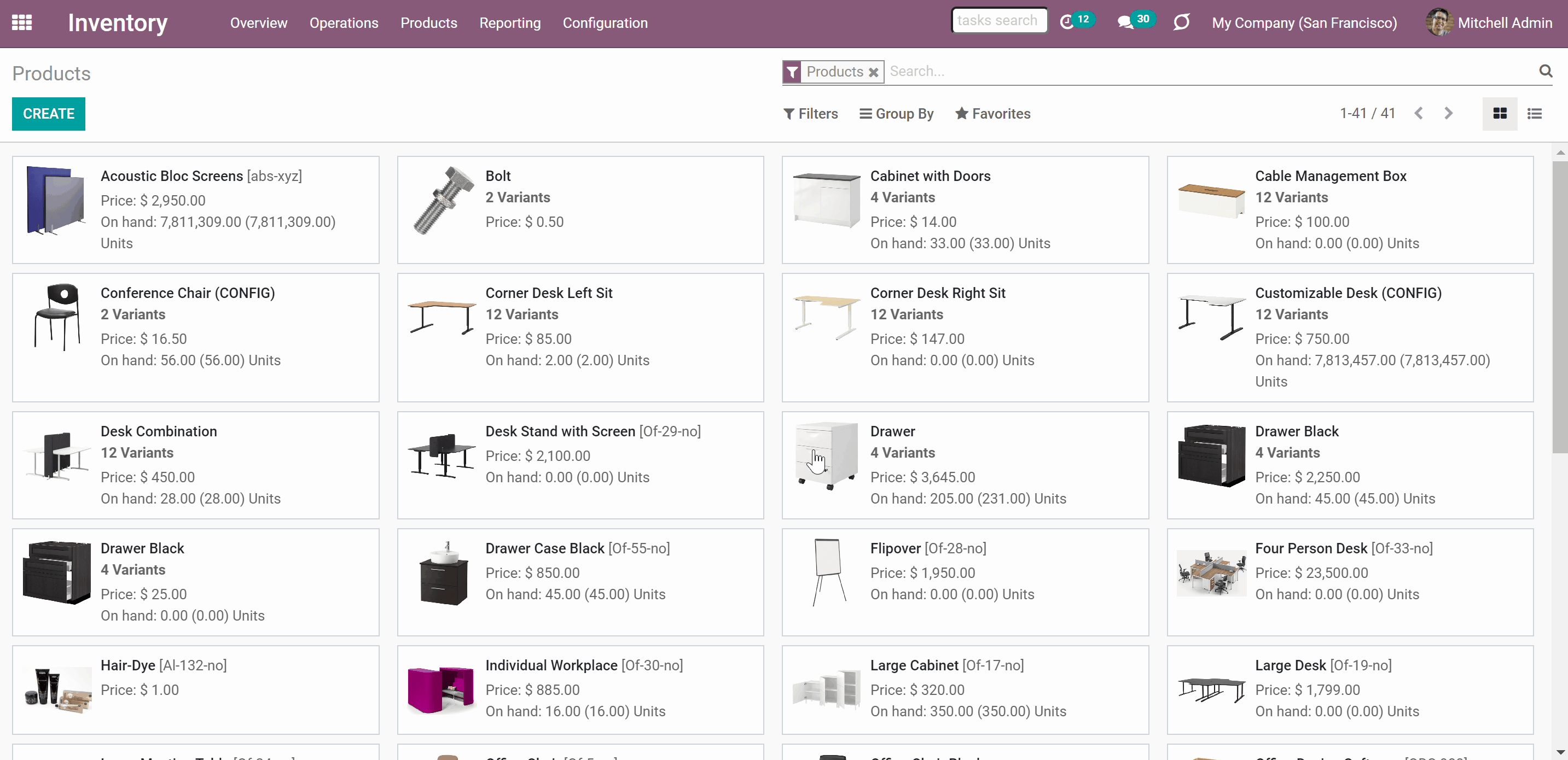
Stocks by Location Configuration
The module's tables with the product quants are updated in real-time. If you have a lot of products, warehouses, and locations, there might be some delays while opening the product's template. In this case, you can replace the table with a button. And the calculations will take place only as you click on the button.
For that, go to Inventory > Configurations > Settings and find the section 'Stocks by locations'. There, tick the box 'Stocks by locations: button only'.
After checking the box, the button to open the table would be shown instead of the table. Such an approach allows facilitating loading of product forms since compute methods would be applied only after pushing the above button.
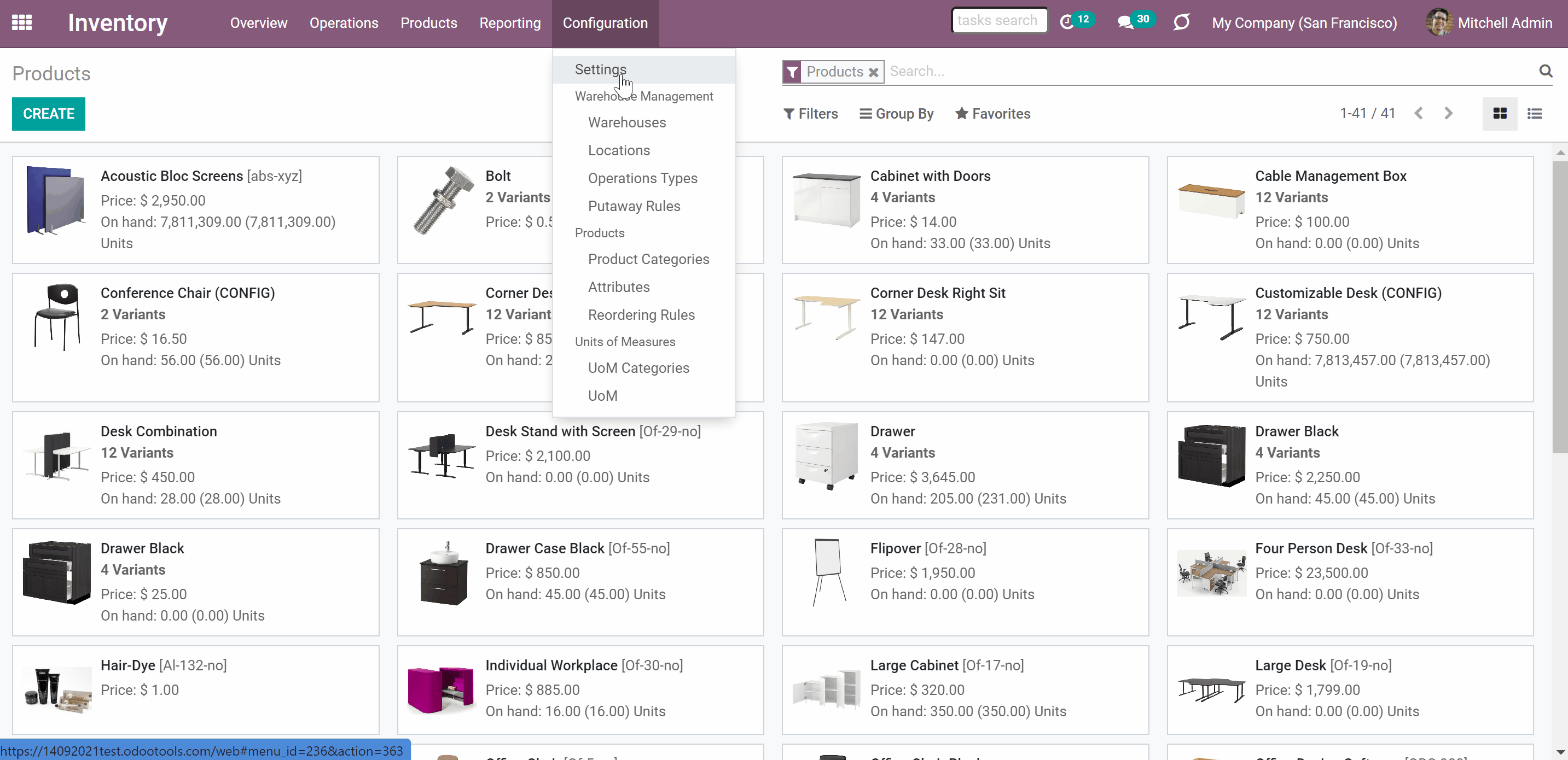
You can specify how many levels of locations' hierarchy will be shown by default. Others would be hidden until expanded manually.
To set the number of shown hierarchy levels, go to Inventory > Configurations > Settings and find the section 'Stocks by locations'. There find the line default levels expanded, and type the number. For example, if you type '1', then only the first level of locations' hierarchy will be shown by default, but users would be still able to expand to see other levels (see Interfaces).
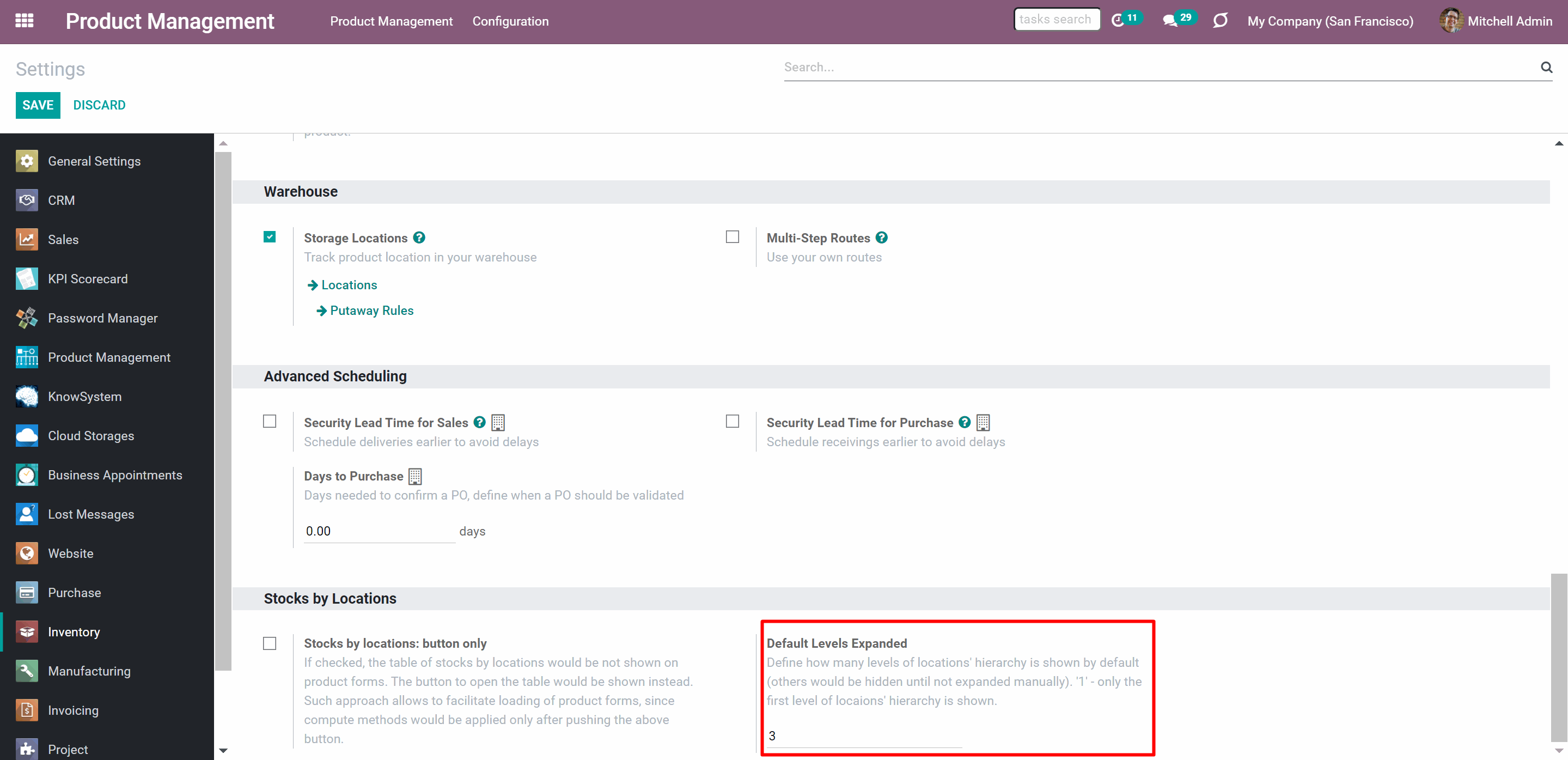
About Stocks by Locations
Stocks by Locations is an Odoo module to provide essential inventory data for products at a glance, and to keep details by locations easy reachable and clear.
The app introduces the widget for product templates, variants, and sale orders to work with stocks in a comfortable manner. The internal locations are structured hierarchically, while you may expand or hide any of those. Locations without products on hand or without products planned are excluded to provide a clearer picture.
Get an instant overview of stock levels from product variant or template forms, and right from a sales line. You would have full information over all available internal locations for quantity on hand, free to use quantity, reserved quantity, forecast quantity, incoming and outgoing quants.
At a glance at products, users observe the inventories which are essential for them. So, Odoo stock levels are calculated for the default warehouse, but total inventories are still available.
Export stock levels in a single button click right from a product form.
Expandable locations' hierarchy
Inventory for products and sale lines
User warehouse inventory levels
Excel table inventories by locations
Odoo Product Inventory Interfaces
The aim of the module is to show inventory levels per each internal location for backend comfortable use. For that, the module introduces the widget. The widget shows a table, which gives an instant overview of stock levels from product variant or template forms, and right from a sales line. You would have full information over all available internal locations for quantity on hand, free to use quantity, reserved quantity, forecast quantity, incoming and outgoing quants.
The internal locations are structured hierarchically, while you may expand or hide any of those.
To expand the hidden warehouses, click on the 'Down Arrow' icon by the warehouse or location.
To hide the open warehouses, click on the 'Up Arrow' icon by the warehouse or location.
You can also expand all warehouses in one click. For that, find the 'Double Arrows' on the left side of the title 'Location'.
The 'Side Arrow' stands by the last location, which can no longer be expanded.
Locations without products on hand or without products planned are excluded to provide a clearer picture.
Below the table, you can find the button 'Export to XLSX' click on it to export the stock balance table (see Stock Levels Export).

The module updates the stock balance in real-time. But, there might be some delays, when there are a lot of products and warehouses. To avoid high system resource consumption, it is also possible to hide the table and show the button instead (see Stocks by Locations Configuration).
The module doesn't influence user's access rights. The access rights are regulated by Odoo or might be regulated by other third-party apps. If there are some limitations to the warehouses or locations, then users will not see them. So, it is possible, that the table will look differently for various users.
The widget appears on:
1. Product template
2. Product variants' forms
3. Sale Order's form
Product Template
The 'Stocks by locations' widget is added to each storable and consumable product template. To see the availability of a particular product, just open the product's card, go to the tab Inventory and find the section Stock Balance by Locations. There you will find a table, which shows the number of this product in each warehouse.
As a product is a group of variants (items) of one model, the quantity is shown for all its variants.
Click on the button 'Export to XLSX' to export the stock balance table (see Stock Levels Export).

The module also changes the button on the product's form. Now the available quantity of the product is shown not in all warehouses, but only in the default one. The available quants for all product variants are shown. Thus, users observe the inventories which are essential for them. However, a user still can check other warehouses using the widget ‘Stocks by locations’ if necessary.
The default warehouse can be configured on the user form right under the Signature.
Here, in the picture, the user's default warehouse is 'WH'. So, the number in the button, which is higher shows the stocks of the 'WH' warehouse, that is 428.00 Units. And the number below, 454.00, shows total stocks by all locations.

The information about the quantity of the product in the default warehouse can be also seen from both the kanban and list view of the product. The second number shows the quantity of the product in all locations.

Product Variant's Form
The 'Stocks by locations' widget is added not only to the storable and consumable product's template but also to the storable and consumable product's variants' forms. A product variant is a specific version of a particular product. So, it is also possible to see the quants of a particular product variant in various locations.
To see stocks of a product variant:
1. Open the product's template and click on the button 'Variants'
2. Choose a variant and open its form
3. Find the section 'Stocks by location'
Click on the button 'Export to XLSX' to export the stock balance table (see Stock Levels Export).

You can also open the product variant from the product variant's menu by going to Inventory > Products > Product Variants. There as in the product's template you will see the button, which shows the available quantity of the product variant in the default warehouse. Thus, users observe the inventories which are essential for them. However, a user still can check other warehouses using the widget ‘Stocks by locations’ if necessary.
Here, in the picture, the user's default warehouse is 'WH'. So, the number in the button, which is higher shows the stocks of the 'WH' warehouse, that is 100.00 Units. And the number below, 155.00, shows the total stocks of the product variant by all locations.

The information about the quantity of the product variant in the default warehouse can be also seen from the list view in the product variant's menu. The second number shows the quantity of the product in all locations.

Sale Order's Form
The module introduces the tool for Odoo salespersons to control inventory levels when working with quotations. With the 'Stock by locations' widget, you can get an instant overview of stock levels right from a sales line.
To see the stocks of a product from a sale order, just click on the 'List' icon by the product, on the right side, after the 'Subtotal' column.
The table contains full information over all available internal locations for quantity on hand, free-to-use quantity, reserved quantity, forecast quantity, incoming and outgoing quants.
The module helps to check the availability of a product in all locations if there isn't enough product in stock in the default one.
For example, a sale order for 10 drawers was created. However, in the default warehouse, there were only 8 drawers. So, the salesperson checks the availability of the drawers in other places and suggests the buyer waiting in case the delivery will take longer.

Stock Levels Export
It is possible to export the product's stock levels. For that,
1. Open a product template or a product's variant form
2. Go to the tab 'Inventory'
3. Find the tab 'Stock balance by locations'
4. On the right side below the table click the button 'Export to XLSX' and the downloading will start automatically.
The exported document preserves the table 'Stock by Locations' structure. The hierarchy levels are presented. You see full information over all available internal locations for quantity on hand, free-to-use quantity, reserved quantity, forecast quantity, incoming and outgoing quants.

Stocks by Location Configuration
The module's tables with the product quants are updated in real-time. If you have a lot of products, warehouses, and locations, there might be some delays while opening the product's template. In this case, you can replace the table with a button. And the calculations will take place only as you click on the button.
For that, go to Inventory > Configurations > Settings and find the section 'Stocks by locations'. There, tick the box 'Stocks by locations: button only'.
After checking the box, the button to open the table would be shown instead of the table. Such an approach allows facilitating loading of product forms since compute methods would be applied only after pushing the above button.

You can specify how many levels of locations' hierarchy will be shown by default. Others would be hidden until expanded manually.
To set the number of shown hierarchy levels, go to Inventory > Configurations > Settings and find the section 'Stocks by locations'. There find the line default levels expanded, and type the number. For example, if you type '1', then only the first level of locations' hierarchy will be shown by default, but users would be still able to expand to see other levels (see Interfaces).
